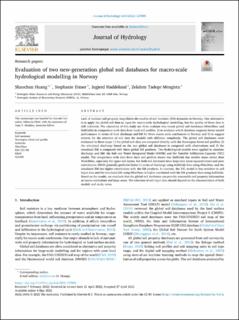| dc.contributor.author | Huang, Shaochun | |
| dc.contributor.author | Eisner, Stephanie | |
| dc.contributor.author | Haddeland, Ingjerd | |
| dc.contributor.author | Mengistu, Zelalem Tadege | |
| dc.coverage.spatial | Norway | en_US |
| dc.date.accessioned | 2022-06-02T08:25:22Z | |
| dc.date.available | 2022-06-02T08:25:22Z | |
| dc.date.issued | 2022 | |
| dc.identifier.issn | 0022-1694 | |
| dc.identifier.uri | https://hdl.handle.net/11250/2997329 | |
| dc.description.abstract | Lack of national soil property maps limits the studies of soil moisture (SM) dynamics in Norway. One alternative is to apply the global soil data as input for macro-scale hydrological modelling, but the quality of these data is still unknown. The objectives of this study are 1) to evaluate two recent global soil databases (Wise30sec and SoilGrids) in comparison with data from local soil profiles; 2) to evaluate which database supports better model performance in terms of river discharge and SM for three macro-scale catchments in Norway and 3) to suggest criteria for the selection of soil data for models with different complexity. The global soil databases were evaluated in three steps: 1) the global soil data are compared directly with the Norwegian forest soil profiles; 2) the simulated discharge based on the two global soil databases is compared with observations and 3) the simulated SM is compared with three global SM products. Two hydrological models were applied to simulate discharge and SM: the Soil and Water Integrated Model (SWIM) and the Variable Infiltration Capacity (VIC) model. The comparison with data from local soil profiles shows that SoilGrids has smaller mean errors than Wise30sec, especially for upper soil layers, but both soil databases have large root mean squared errors and poor correlations. SWIM generally performs better in terms of discharge using SoilGrids than using Wise30sec and the simulated SM has higher correlations with the SM products. In contrast, the VIC model is less sensitive to soil input data and the simulated SM using Wise30sec is higher correlated with the SM products than using SoilGrids. Based on the results, we conclude that the global soil databases can provide reasonable soil property information at coarse resolutions and large areas. The selection of soil input data should depend on the characteristics of both models and study areas. | en_US |
| dc.language.iso | eng | en_US |
| dc.publisher | Elsevier | en_US |
| dc.rights | Attribution-NonCommercial-NoDerivatives 4.0 Internasjonal | * |
| dc.rights.uri | http://creativecommons.org/licenses/by-nc-nd/4.0/deed.no | * |
| dc.subject | Soil moisture | en_US |
| dc.subject | Norwegian forest soil profile | en_US |
| dc.subject | SoilGrids | en_US |
| dc.subject | Wise30sec | en_US |
| dc.subject | ESA CCI SM | en_US |
| dc.subject | ERA5 | en_US |
| dc.subject | GLEAM | en_US |
| dc.title | Evaluation of two new-generation global soil databases for macro-scale hydrological modelling in Norway | en_US |
| dc.type | Journal article | en_US |
| dc.source.journal | Journal of Hydrology | en_US |
| dc.source.issue | 610 | en_US |
| dc.identifier.doi | https://doi.org/10.1016/j.jhydrol.2022.127895 | |

